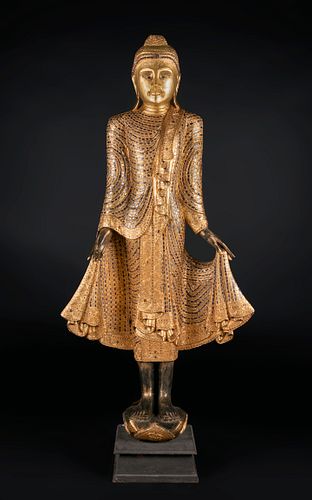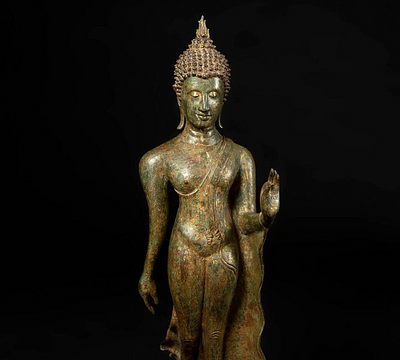Thai school, mid-twentieth century. "Buddha".
Lot 40
About Seller
Setdart Auction House
Carrer Aragó 346
Barcelona
Spain
Setdart Subastas was born in 2004 and is currently the first online art auction in Spain with solidity, prestige and reliability guaranteed by our more than 60,000 users. Setdart has a young, dynamic and enterprising team ready to successfully manage the purchase and sale of art works through custom...Read more
Estimate:
EUR€2,000 - EUR€2,500
$2,150.54 - $2,688.17
Absentee vs Live bid
Two ways to bid:
- Leave a max absentee bid and the platform will bid on your behalf up to your maximum bid during the live auction.
- Bid live during the auction and your bids will be submitted real-time to the auctioneer.
Bid Increments
| Price | Bid Increment |
|---|---|
| EUR€0 | EUR€10 |
| EUR€200 | EUR€25 |
| EUR€500 | EUR€50 |
| EUR€1,000 | EUR€100 |
| EUR€3,000 | EUR€200 |
| EUR€5,000 | EUR€500 |
| EUR€10,000 | EUR€1,000 |
| EUR€20,000 | EUR€2,000 |
| EUR€50,000 | EUR€5,000 |
About Auction
By Setdart Auction House
Nov 22, 2021
Set Reminder
2021-11-22 10:00:00
2021-11-22 10:00:00
America/New_York
Bidsquare
Bidsquare : 22nd November - Oriental Art
https://www.bidsquare.com/auctions/setdart-auction-house/22nd-november---oriental-art-7877
Setdart Auction House sofia@setdart.com
Setdart Auction House sofia@setdart.com
- Lot Description
Thai school, mid-twentieth century. "Buddha". Lacquered wood, gilded and with mirror glass applications. Measurements: 180 x 90 x 28 cm (sculpture); 13,5 x 37 x 37 cm (wooden base). Buddha statue of Mandalay style, period dated between 1853 and 1948, initiated with the transfer of the capital from Amarapura to Mandalay and ending with the independence of the United Kingdom. Buddha images from this period are youthful, sweet-faced and dressed in rich robes carefully folded, embroidered and often decorated with mirrored stones and crystals. Sculptures before this time throughout Southeast Asia tended to depict monastic habits in a much more schematic manner. In the Mandalay period greater realism emerges in the features of the Buddha and his attire. The style of the faces is oval with long pointed noses, full lips and almond-shaped eyes defined by arched eyebrows. The facial expression is serene with narrowed eyes, concentrated in meditation and a soft smile on the lips. The hair hugs the head in tight curls and covers a broad, two-dimensional unisha or bulge on the head, representing the knowledge and wisdom the Buddha attained after being enlightened; the unisha sometimes takes the form of a flame indicating enlightenment. The long ears signify the wealth he had during his life as a prince and the curly hair represents the nobility he possesses. Images of the standing Buddha are often shown in the Varada mudra, a sacred gesture of blessing. It is a very characteristic iconographic representation of Buddhist sculpture in a standing position in Burma. It symbolizes the blessing of the Buddha with a significance of offering, charity and compassion. The Varada Mudra is an important iconic gesture, showing the Buddha's hand with the fingers pointing downward and with the palm turned slightly away from the body. The turned palm indicates that the figure is bestowing his blessing on the viewer. The left hand may perform a different mudra, although it may also appear in this same mudra by lightly gathering the mantle. The representation shows several lakshana, iconographic symbols that identify Buddhas and bodhisattvas. The first we see is the hair that in tight curls wraps a wide unisha staggered at two heights, symbol of meditation, of concentrated spiritual life and wisdom. We also see the marked eyebrows, a point from which emanates the light of wisdom that illuminates all beings. The eyelids are a symbol of spiritual concentration and purity because of their similarity to the petals of the lotus, and complete a serene face with a sketched smile, symbol of the balance and serenity of a perfect being. The elongated earlobes allude to the large earrings worn by members of the upper classes in India contemporary to Gautama Siddartha and represent the concepts of greatness, nobility and wisdom. Another lakshana present here are the folds in the neck, symbolizing happiness. He is dressed in wide pleated robes richly ornamented with inlaid borders of polychrome crystals and mirror. The uttarasanga wraps around the torso like a cape covering the arms and chest and falls in wide pleats on both sides of the body and the sanghati flows in numerous pleats from the left shoulder. The complex system of folds of the vestments stands out, which together with the inlaid ornamentation underlines the magnificence of the Buddha. He wears on his head a wide diadem adorned with floral decoration.
- Shipping Info
-
In-house shipping available. Please inquire at admin@setdart.com.
-
- Buyer's Premium



 EUR
EUR CAD
CAD AUD
AUD GBP
GBP MXN
MXN HKD
HKD CNY
CNY MYR
MYR SEK
SEK SGD
SGD CHF
CHF THB
THB







